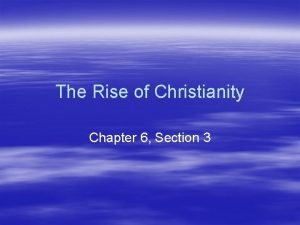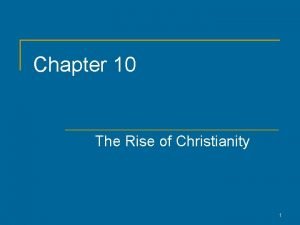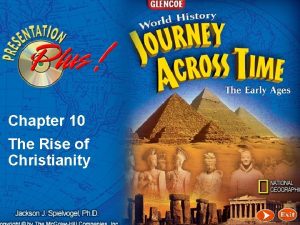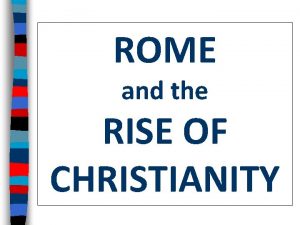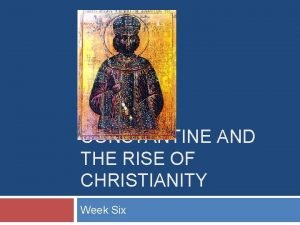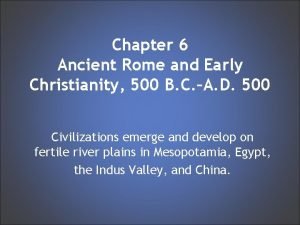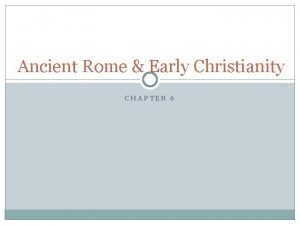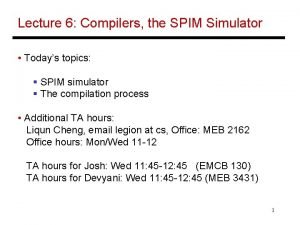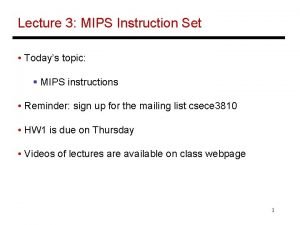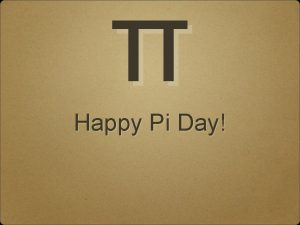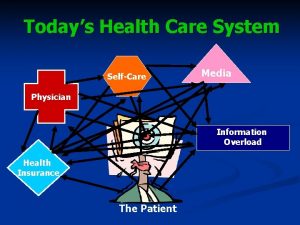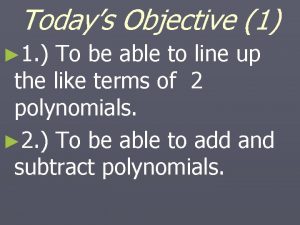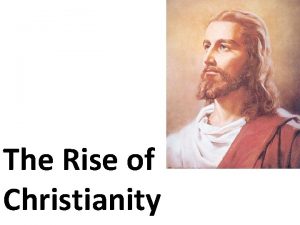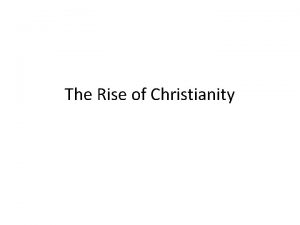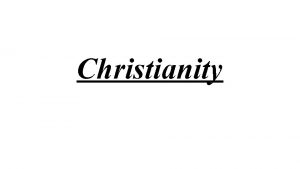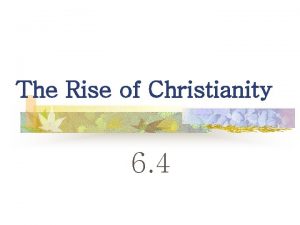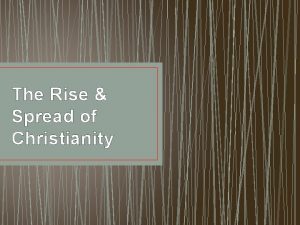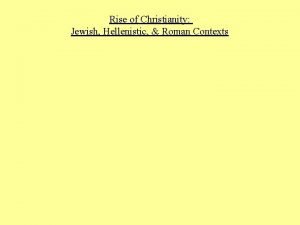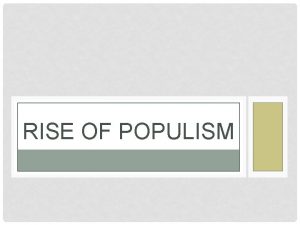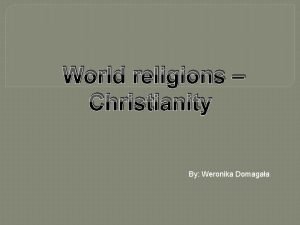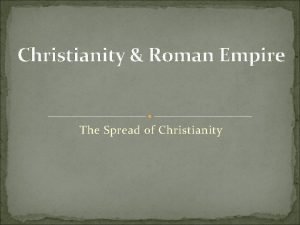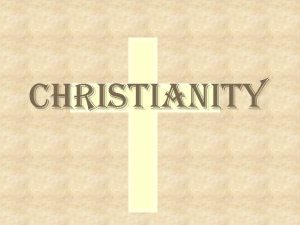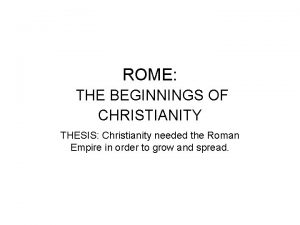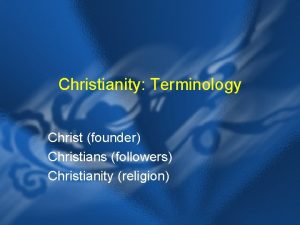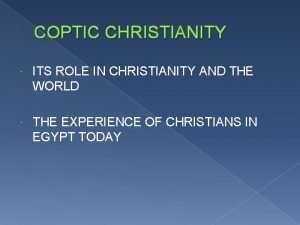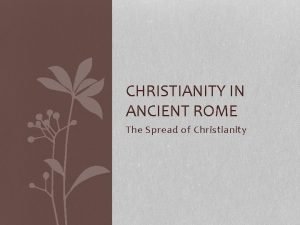Chapter 10 The Rise of Christianity 1 Todays


























- Slides: 26

Chapter 10 The Rise of Christianity 1

Today's Agenda Learning Target: I can understand how the Christian Religion expanded across Europe and eventually transformed from a unorganized religion to the Roman Catholic Church and the Eastern Orthodoxy Church (1)Collaborative Group Activity Cornell Notes (20 – 30 Minutes) > Section 2 (2)L/D Chapter 10 Section 2 (20 – 30 Minutes)

Did You Know. . . Note Taking Did you know that when you take notes, you remember more than three-fourths of the information you recorded? That is why it is important to learn to take careful notes as you are reading.

Section I – The Jews and the Romans Chapter 3: Kings David and Solomon united Israel, Capital: Jersusalem Later Israel was divided into 2 Kingdoms: Israel and Judah's name changed into Judaea by Emperor Augustus in 6 CE – Replaced Jewish Kings to Roman Procurators (Governors) Jewish monotheism at odds with most ancient cultures Refusal to recognize state gods 4

Section I – The Jews and the Romans Zealot → a member of a radical patriotic group of Jews in Judaea who advocated the overthrow of Roman Rule. Zealots rebelled in 66 CE Romans crushed the Jewish self-governance in Jewish Wars (66 – 70 CE) Jews rebelled again in 132 CE and are crushed – Punishment: Romans forced Jews to leave Jerusalem 700 CE: Jews set up different communities in Europe and Central Asia 5

Section I – The Life of Jesus Jews believed that God would send a Messiah, or promised and expected deliver of the Jewish people Jesus of Nazareth → Jewish teacher who traveled through Judaea and Galilee – Moral code, reputation of miracle-working – Assembled a small group of followers called disciples Sermon on the Mount → a discourse delivered by Jesus to the disciples and others, containg important fundementals of Christan Teaching Jesus used Parables; a short story designed to illustrate or teach some truth, religious principle, or moral lesson – The Prodigal Son – The Good Samaratan 6

The Parable of the Good Samaritan Jesus giving his famous “Sermon on the Mount”

Section I – The Life of Jesus celebrates Passover with his disciples called the “Last Supper” in 33 CE Romans fear instigation of rebellion, crucify, to put to death by nailing or binding the hands and feet to a cross, Jesus for treason – Jesus was betrayed by which disciple? – What is Treason? Jesus' followers believe in Jesus resurrection, or rising from the dead – They founded a new religion called Christianity 8

The Last Supper Leonardo da Vinici's painting “The Last Supper”

Section I – The First Christains Jesus' title changed to Christ from the Greek word Christos meaning “Messiah” Teachings recorded in New Testament Followers of Jesus teachings are called Christains Apostles, any of the early followers of Jesus who spread the Christain message into the world, helped establish churches – Peter and Paul most important Simon Peter, an original disciple of Jesus, spread his message in Rome and according to Christain tradition he established the Roman Catholic Church 10

Section I – The First Christains Paul (Saul) of Tarsus was at first against Christianity and then converted after he saw the “Light” – Paul traveled widely throughout the Roman Empire and founded churches around the Mediterranean Christains and Jews have different beliefs – Christains believe that Jesus is the Messiah and Son of God – Belief in salvation, to be saved from sin and allowed to enter heaven, by accepting Jesus – Belief in the Trinity or one God who exists as three persons: Father, Son, and Holy Spirit. 11

Spread of Christianity A. D. 325

Section II – A Growing Faith Christianty spread throughout Rome Appealed to the Urban poor and women → gave hope for change and new roles for women Christain ideas were familiar to many Romans Gave people an opportunity to give charity to others Roman Government began persecuting Christians – Emperor Nero accused Christians of starting the “Great Fire of Rome” – Christianity became illegal Martyrs → a person who willingly suffers death rather than renounce his or her beliefs/religion Diocletian was the last Emperor to carry out Christain persecutions 13

Section II – Diocletian and Chapter 9 Constantine – Diocletian divided empire into 2 administrative districts – Civil War follows after Diocletian's death and Constantine emerges victorious 312 CE → Constantine converts to Christianity – “Hoc signum in vos vincetis” → Latin: “In this sign you will conquer” – 313 CE → Constantine issued the Edict of Milan, which allowed Christians to practice their relligion openly in the Roman Empire • With help of his mother Helena, Constantine built churches in Rome and Jerusalem 392 CE → Emperor Theodosius proclaims Christianity the official religion of the Roman Empire 14

Section II – The Early Church A Hiearchy, an organized body of ecclesiastical officials, in successive ranks or orders, was established by the Romans – The Clergy (Cleric) are leaders of the Church and had different roles from the Latiy or regular church members – Women were not allowed to be members of the Clergy Local Church Clerics later became to be called priests Several churches formed a diocese, which is an ecclesiastical district under the jurisdiction of a bishop – Some bishops were in charge of entire regions and were called archbiships – The 5 leading archbishops were called patriarchs 15


Section II – The Early Church A Doctrine, a church teaching, was created by bishop meetings that discussed the Christian faith The Christian Texts (New Testement) + Jewish Hebrew Scriptures (The Old Testement) = The Christian Bible (Christian Holy Book) – Jesus' teachings are recorded as the New Testement – These writings were written by Matthew, Mark, Luke, and John and it came to be called a “gospel” Saint Augustine, a Bishop in North Africa, influenced early Christianity and defended Christianity in his writings – The City of God – History book written from a Christian viewpoint – Confessons 17

Section II – The Early Church The Bishop of Rome – Patriarch of the West – Began claiming power over other Bishops – Believed to have the authority of Peter – Diocese was in Rome, the Empire's capital 600 CE → The Bishop of Rome gained the title of “Pope” The Latin speaking Christians accepted this and their Churches became known as the Roman Catholic Church – This causes disputes between the Eastern and Western Christian Churches 18

Section III – The Byzantine Church The Greek-speaking Christians in the East developed their own form of Christianity, the Eastern Orthodox Church or the Greek Orthodox Church The Byzantine Empire believed in theory in Caesarpapism, is when the possession of the supreme authority over church and state is controlled by one person, often a secular (Non-Church) ruler – The Byzantine Emperor was the leader of the Byzantine Church and appointed the Patriarch of Constantinople, who was the religious church leader of the Byzantine Church The Byzantine Church argued over the use of icons, images of Jesus, Mary, the saints, or other Christian holy people Emperor Leo III ordered all icons to be removed from Churches, and iconoclasts carried out this order 19

Section III – The Byzantine Church Eastern Church members opposed the pope's claim as head of all Christian churches Church – Byzantine: Greek – Roman: Latin – Conflicts over hierarchiacal control Germanic peoples establish their own states (Vandals, Visigoths, Franks, Anglo-Saxons, etc. . . ) Roman Pope Leo III crowned Charlemange Holy Roman Emperor, this challenged Byzantine authoruty Western Church Leader (Pope) appointed the Emperor and the Byzantine Emperor apponted the Eastern Church Leader (Patriarch) 20

Section III – The Great Schism Arguments over hierarchy, jurisdiction 1054 CE Patriarch of Constantinople and Pope of Rome excommunicate each other Schism → a formal division within, or seperation from, a church or religious body over some doctrinal difference – East: Orthodox Church – West: Roman Catholic 21

Spread of Christianity A. D. 325– 1100

The spread of Buddhism, Hinduism, and Christianity, 200 BCE – 400 CE

Section III – Christian Ideas Spread Christianity helped people achieve order after the fall of Rome Religious men called Monks came together and formed communities called Monasteries Religious Women became Nuns and formed Religious communites called convents – Paula gave up her wealth to build churches, hospitals, and a convent in Palestine She also helped translate the Bible into Latin Basil created rules for monks and nuns called the Basilian Rule, these rules became the model for monastaries and convents in the East Benedict wrote another set of rules called the Benedictine Rule, which became the model for monastaries and convents in the West 24

Section III – Missionaries are people who teach their religion to those who do not believe Cyril (Byzantine) was a missionary who created the Cyrillic alphabet to aid the Slavic people in understanding the Bible in 863 CE Anglos and Saxons invaded Britain and united to form the Anglo-Saxons – The Celts, who lived in Britain before the invasion of the Anglos and Saxons, fled to Ireland – Patrick was a priest who brought Christianity to Ireland – Pope Gregory I sent 40 monks to spread Christianity in England – Ethelbert of Kent contributed to the building of a church in Canterbury, which today is still an importnant center of Christianity 25

 The rise of christianity chapter 6 section 3
The rise of christianity chapter 6 section 3 Chapter 10 the rise of christianity
Chapter 10 the rise of christianity Chapter 10 the rise of christianity
Chapter 10 the rise of christianity Rome and the rise of christianity
Rome and the rise of christianity Constantine cannon
Constantine cannon Rise and rise until lambs become lions
Rise and rise until lambs become lions Tricky dicky richard nixon
Tricky dicky richard nixon Little lambs academy
Little lambs academy Rise and rise again until lambs become lions origin
Rise and rise again until lambs become lions origin Chapter 13 marketing in today's world
Chapter 13 marketing in today's world Chapter 6 ancient rome and early christianity
Chapter 6 ancient rome and early christianity Chapter 6 ancient rome and early christianity
Chapter 6 ancient rome and early christianity Todays generations
Todays generations We are going today
We are going today Todays with apostrophe
Todays with apostrophe Todays worldld
Todays worldld Define radient energy
Define radient energy Todays globl
Todays globl Todays wordlw
Todays wordlw Todays plan
Todays plan Todays sabbath lesson
Todays sabbath lesson Todays sabbath school lesson
Todays sabbath school lesson Walsall rugby
Walsall rugby Todays health
Todays health Today's objective
Today's objective No thats not it
No thats not it Todays objective
Todays objective
